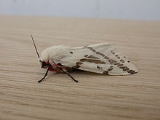
Spilosoma canescens
Encyclopedia
Ardices canescens, the Dark-spotted Tiger Moth or Light Ermine Moth, is a moth
in the family Arctiidae
that is found across most of Australia
. Formerly included in Spilosoma
, but later generic status of Ardices
was proved. The larvae are polyphagous, and are known to feed on Bidens pilosa
, Helianthus annuus, Taraxacum officinale
, Alcea rosea
, Rosa odorata, Plantago
, Ricinus communis and Tradescantia albiflora. The polyembrionic parasitoid
wasp Copidosoma floridanurn sometimes uses this species of caterpillar as a host.
Moth
A moth is an insect closely related to the butterfly, both being of the order Lepidoptera. Moths form the majority of this order; there are thought to be 150,000 to 250,000 different species of moth , with thousands of species yet to be described...
in the family Arctiidae
Arctiidae
Arctiidae is a large and diverse family of moths with around 11,000 species found all over the world, including 6,000 neotropical species. This family includes the groups commonly known as tiger moths , which usually have bright colours, footmen , lichen moths and wasp moths...
that is found across most of Australia
Australia
Australia , officially the Commonwealth of Australia, is a country in the Southern Hemisphere comprising the mainland of the Australian continent, the island of Tasmania, and numerous smaller islands in the Indian and Pacific Oceans. It is the world's sixth-largest country by total area...
. Formerly included in Spilosoma
Spilosoma
Spilosoma is a genus of moths in the Arctiidae family. It is very heterogeneous genus, and needs in a serious review. Probably, some species should be separated into own genera.- Species more or less related to the type species :...
, but later generic status of Ardices
Ardices
Ardices is a genus of moth in the family Arctiidae from Australia.-Species::* Ardices canescens Butler, 1875* Ardices glatignyi -Subgenus Australemyra Dubatolov, 2005::* Ardices curvata...
was proved. The larvae are polyphagous, and are known to feed on Bidens pilosa
Bidens pilosa
Bidens pilosa, commonly known as Spanish Needle, is a species in the plant family Asteraceae. It is an annual that grows up to 1 meter in height....
, Helianthus annuus, Taraxacum officinale
Taraxacum officinale
Taraxacum officinale, the common dandelion , is a herbaceous perennial plant of the family Asteraceae . It can be found growing in temperate regions of the world, in lawns, on roadsides, on disturbed banks and shores of water ways, and other areas with moist soils. T...
, Alcea rosea
Alcea rosea
Alcea rosea is an ornamental plant in the Malvaceae family....
, Rosa odorata, Plantago
Plantago
Plantago is a genus of about 200 species of small, inconspicuous plants commonly called plantains. They share this name with the very dissimilar plantain, a kind of banana. Most are herbaceous plants, though a few are subshrubs growing to 60 cm tall. The leaves are sessile, but have a narrow...
, Ricinus communis and Tradescantia albiflora. The polyembrionic parasitoid
Parasitoid
A parasitoid is an organism that spends a significant portion of its life history attached to or within a single host organism in a relationship that is in essence parasitic; unlike a true parasite, however, it ultimately sterilises or kills, and sometimes consumes, the host...
wasp Copidosoma floridanurn sometimes uses this species of caterpillar as a host.

